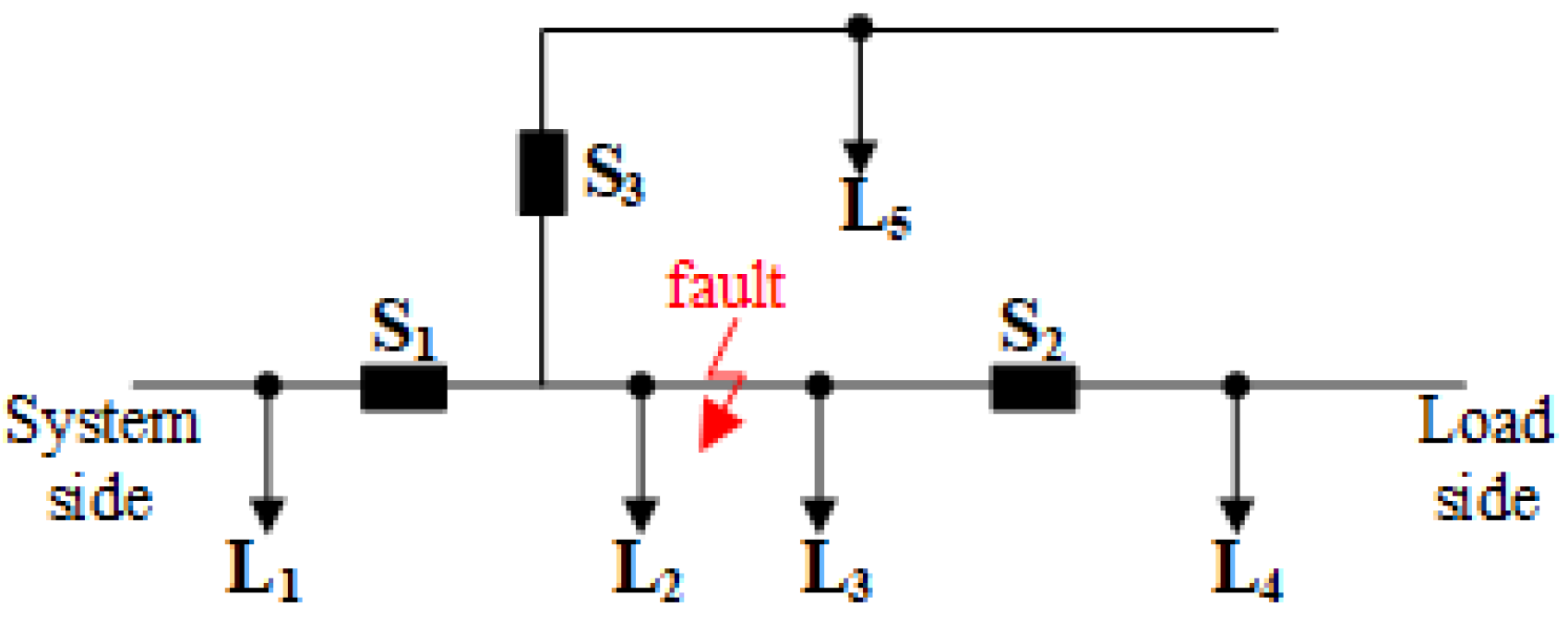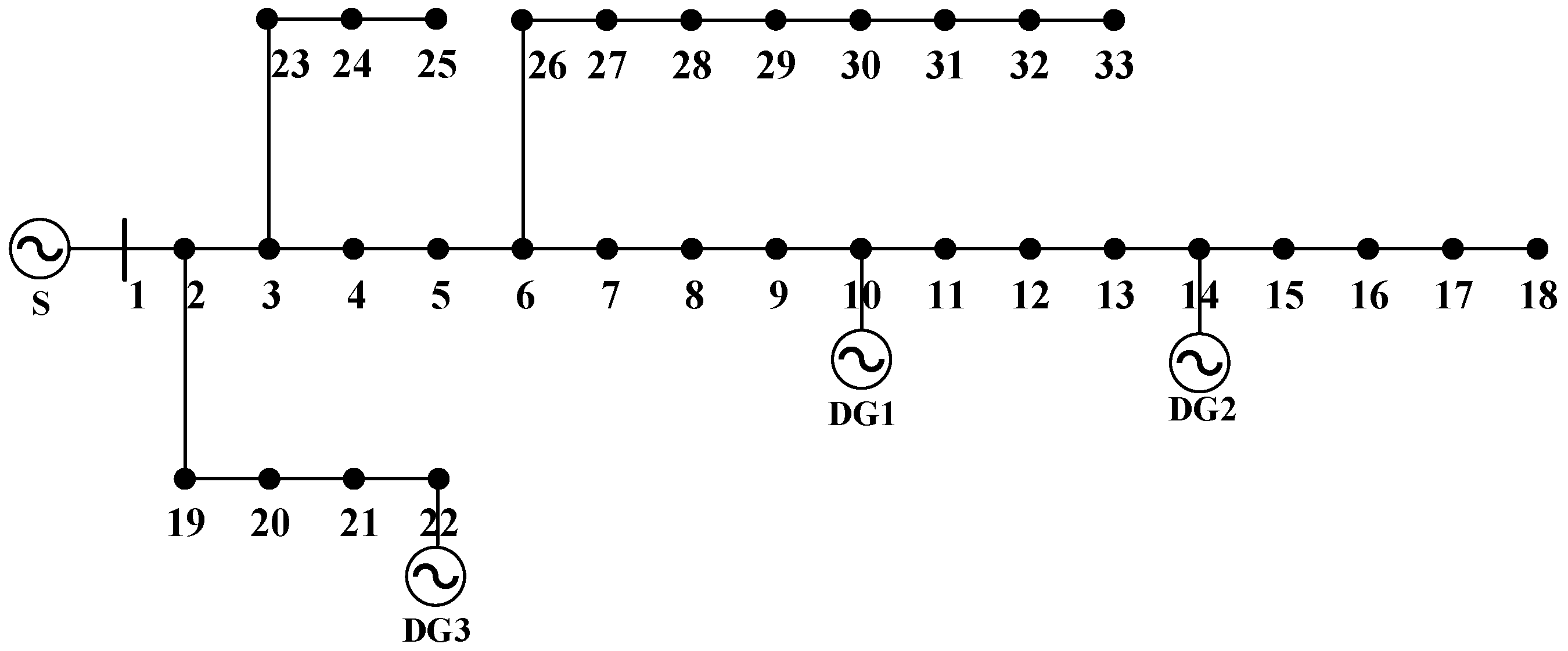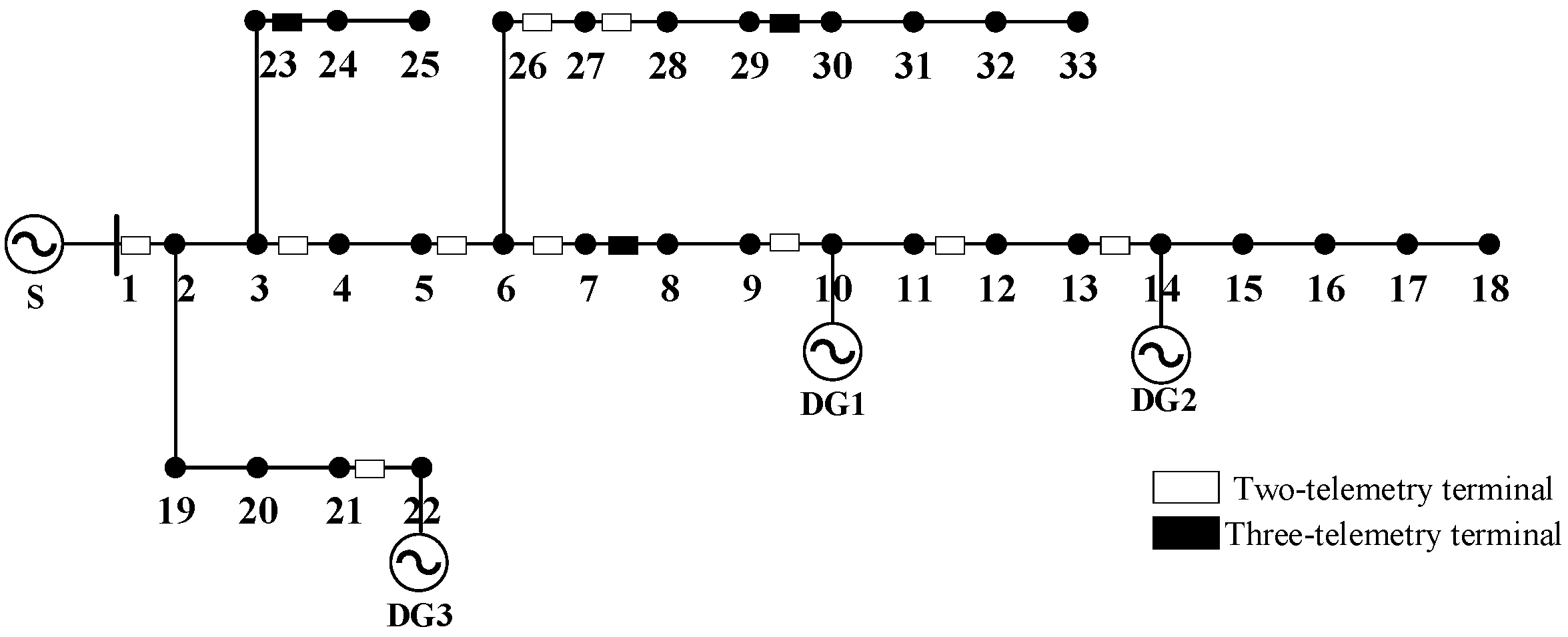Optimal Configuration of Feeder Terminal Units in Power Distribution Networks Considering Distributed Generation
Abstract
1. Introduction
2. Content Related to Feeder Automation
2.1. Concepts of Feeder Terminal Units
2.2. The Working Principle of Feeder Automation
- (1)
- In the case of a transient fault, after the CB trips, it will automatically reclose after a certain period of time, and the power supply of the line will be restored.
- (2)
- In the case of a permanent fault, the CB will trip again after reclosing. The FTUs in the line will detect the fault current twice and send the fault information to the distribution main station. After receiving the information, the distribution main station will analyze the fault information and determine the fault location. If FTU2 is a “two-telemetry” device, the staff need to go to the site in a timely manner to operate the corresponding switch for fault isolation. If FTU3 is a “three-telemetry” device, it can automatically control the switch to open and quickly isolate the fault area. After QL2 and QL3 trip to isolate the fault, the CB is reclosed, and the DG in the network will continue to operate in parallel with the grid and participate in the power grid reconstruction after the fault, so as to restore the power supply to the non-fault area. If FTU3 is not configured for QL3, after the fault occurs, QL4 needs to act to isolate the fault. In this case, the DG is located within the fault area, and the fault isolation will lead to the disconnection of the DG from the distribution network, resulting in a waste of power resources.
3. Mathematical Model for the Optimal Configuration of Distribution Terminals
3.1. Objective Function
3.2. Investment Cost of FTU Equipment
3.3. Load Power Outage Loss Cost
3.3.1. The Influence of FTU Location
3.3.2. The Division of Fault Region and Non-Fault Region
3.3.3. Cost of Power Outage Loss
3.4. The Off-Grid Loss Cost of DG
3.4.1. The Off-Grid Probability of DG
3.4.2. Calculation of the Importance of DG Considering Capacity Size
3.4.3. The Off-Grid Loss Cost of DG
3.5. Constraint Conditions
3.5.1. The Average Service Available Index
3.5.2. Installation Constraints of FTUs
- 1.
- Constraints on the Type of FTU at the Same Location
- 2.
- Constraints on the Total Number of FTUs Installed in the Network
3.5.3. Investment Cost Constraints
4. Model-Solving Process
5. Simulation Analysis
5.1. Scene Topology and Parameter Selection
5.2. Analysis of Computational Examples
5.2.1. Computational Example 1
5.2.2. Computational Example 2
5.2.3. Computational Example 3
6. Conclusions
- (1)
- The influence of FTUs of different types and locations on the load outage time was analyzed. Based on this, a new definition method for the load outage time is proposed when there is no FTU between the load and the fault point, thus making the calculation of the load outage time more accurate. The fault area and non-fault area were divided according to the installation location of FTUs, and then the load outage loss models for different areas were established.
- (2)
- A photovoltaic off-grid loss model was established, which makes the FTU configuration model more comprehensive and the optimization results more reasonable. By introducing the total probability model, the off-grid probability of distributed photovoltaics under fault conditions was calculated, and the importance weight was determined according to the capacity of distributed photovoltaics, thus constructing the photovoltaic off-grid loss model.
- (3)
- An optimization model was constructed with the average power supply availability rate and the installation cost and quantity of FTUs as constraint conditions. By using the PSO algorithm, and under the premise of considering the constraint conditions, the optimal configuration scheme of FTUs for the IEEE 33-node distribution network was solved.
Author Contributions
Funding
Data Availability Statement
Conflicts of Interest
Abbreviations
| FTU | Feeder Terminal Unit |
| DG | Distributed Generation |
| PSO | Particle Swarm Optimization |
Variable Explanation
| The initial investment cost of the termina | |
| The power outage loss cost | |
| The disconnection cost of DG from the grid | |
| The number of “two-telemetry” terminal units | |
| The number of “three-telemetry” terminal units | |
| t1 | The fault inspection time |
| t2 | The fault isolation time |
| t3 | The power restoration time of the fault region |
| The power outage times of the region upstream of the fault | |
| The power outage times of the fault region | |
| The power outage times of the region downstream of the fault | |
| The set of fault points on the feeder | |
| The sets of load types in the region upstream of the fault | |
| The sets of load types in the fault region | |
| The sets of load types in the region downstream of the fault | |
| The set of DGs within the region | |
| The load amounts of a certain type of load in the region upstream of the fault | |
| The load amounts of a certain type of load in the fault region | |
| The load amounts of a certain type of load in the region downstream of the fault | |
| The benchmark electricity price of the DG | |
| The power outage loss cost per unit of electricity | |
| P | The capacity of a single DG |
References
- Wang, W. Practical Fault Locating Technology for Medium and High Voltage Distribution Network Based on Fault Record. Master’s Thesis, Zhejiang University, Hangzhou, China, 2024. [Google Scholar]
- Keshavarz, A.; Dashti, R.; Deljoo, M.; Shaker, H.R. Fault location in distribution networks based on SVM and impedance-based method using online databank generation. Neural Comput. Appl. 2022, 34, 2375–2391. [Google Scholar] [CrossRef]
- Zeng, R.; Zhang, Z.; Wu, Q. Fault location scheme for multi-terminal transmission line based on frequency-dependent traveling wave velocity and distance matrix. IEEE Trans. Power Deliv. 2023, 38, 3980–3990. [Google Scholar] [CrossRef]
- Khatib-Tohidkhaneh, F.; Mohammadi-Hosseininejad, S.M.; Saberi, H. A probabilistic electric power distribution automation operational planning approach considering energy storage incorporation in service restoration. Int. Trans. Electr. Energy Syst. 2020, 30, 398–409. [Google Scholar] [CrossRef]
- Huang, Z.; Qin, F.; Zhu, G.; Wang, D.; Yang, M. Fast Fault Location Method for Complex Active Distribution Network Based on Improved Impedance Method. Tech. Autom. Appl. 2023, 42, 80–84. [Google Scholar]
- Elgamasy, M.M.; Elezzawy, A.I.; Kawady, T.A.; Elkalashy, N.I.; Elsadd, M.A. Tracing passive traveling surge-based fault management control scheme in unearthed distribution systems. Electr. Eng. 2024, 106, 5603–5624. [Google Scholar] [CrossRef]
- Tang, J.; Yin, X.; Zhang, Z.; Yang, C.; Ye, L.; Qi, X.W. Survey of fault location technology for distribution networks. Electr. Power Autom. Equip. 2013, 33, 7–13. [Google Scholar]
- Hu, L.; Wang, L.; Zheng, W.; Sun, K.; Hu, Z.; Gao, Q.; Sun, W. Optimal planning of switch points based on comprehensive analysis of grid structure. Power Syst. Clean Energy 2019, 35, 28–35. [Google Scholar]
- Liu, B.; Zhang, X.; Wang, Y.; He, L.; Wang, Z.; Du, M. Optimal layout method of distribution terminals considering the whole process of feeder automatic fault handling. Power Syst. Prot. Control 2023, 51, 97–107. [Google Scholar]
- Li, S.; Wang, Z.; Xu, W.; Wu, J. Practical optimization models and methods for mv feeder segmentation strategies. Power Syst. Technol. 2022, 46, 765–777. [Google Scholar] [CrossRef]
- Li, S.; Wang, Z.; Zeng, H.; Li, W.; Wang, D. Discussion on lean planning and management improvement strategies for first-class distribution networks. Power Syst. Prot. Control 2021, 49, 165–176. [Google Scholar]
- Xu, C. The Real-Time Performance of Communication Network in Distributed Intelligent Feeder Automation System. Master’s Thesis, Shanong University of Technology, Zibo, China, 2012. [Google Scholar]
- Zhang, J.; Tang, J.; Cao, H.; Gao, C.; Yu, T. Life cycle cost model and intelligent optimization of distribution automation terminal unit. Electr. Meas. Instrum. 2020, 57, 81–89. [Google Scholar]
- Wang, X. Research on Distribution Automation System Planning for Power Supply Reliability. Autom. Appl. 2023, 64, 200–202. [Google Scholar]
- Liu, J.; Cheng, H.; Zhang, Z. Planning of terminal unit amount in distribution automation systems. Autom. Electr. Power Syst. 2013, 37, 44–50. [Google Scholar]
- Liu, J.; Lin, T.; Zhao, J.; Wang, P.; Su, B.; Fan, X. Specific planning of distribution automation systems based on the requirement of service reliability. Power Syst. Prot. Control 2014, 42, 52–60. [Google Scholar]
- Chen, R.; Li, X.; Chen, Y. Type and site selection model of distribution terminals and switches adaptive to different network architectures. Autom. Electr. Power Syst. 2022, 46, 151–160. [Google Scholar]
- Sun, L.; Yang, H.; Ding, M. Mixed integer linear programming model of optimal placement for switching devices in distribution system. Autom. Electr. Power Syst. 2018, 42, 87–95. [Google Scholar]
- Farajollahi, M.; Fotuhi-Firuzabad, M.; Safdarian, A. Optimal placement of sectionalizing switch considering switch malfunction probability. IEEE Trans. Smart Grid 2019, 10, 403–413. [Google Scholar] [CrossRef]
- Sun, L.; Yang, Y.; Zhang, C.; Chen, H.; Wang, T.; Jiao, A. Distribution terminal optimal design for distributed generation accessing distribution network. Acta Energiae Solaris Sin. 2021, 42, 120–125. [Google Scholar]
- Liu, J.; Pan, J.; Zhang, S. Optimization of distribution terminal selection considering load and dg randomtiming characteristics. Mech. Electr. Eng. Technol. 2020, 49, 154–157. [Google Scholar]
- Zhao, H.; Ding, J.; Yang, M.; Wang, C.; Qu, G.; Gong, J. Research on voltage and reactive power of system with 10 million kilowatts wind and photovoltaic power. Renew. Energy Resour. 2020, 49, 154–157. [Google Scholar] [CrossRef]
- Li, G. Research on Faulted Section Location Method of Distribution Network Based on Feeder Automation Information. Master’s Thesis, Shandong University, Jinan, China, 2021. [Google Scholar]
- Gao, J.; Diao, N.; Hou, X.; Sun, Y.; Xue, X. Reactive Power Optimization of Active Distribution Network Based on Improved Particle Swarm Algorithm. Tech. Autom. Appl. 2024, 43, 19–23. [Google Scholar]
- Fu, Z. MLR-MPSO-based Arrangement Optimization of Monitoring Points in Transmission Networks. Electr. Eng. 2024, 19, 40–45. [Google Scholar]
- Xiong, R.; Zhao, L.; Zhang, Y. Fault Location of Active Distribution Network Based on GWO-PSO Algorithm. Proc. CSU-EPSA 2024, 1–10. [Google Scholar]
- Sun, S. A Method for Solving Large Scale Multiobjective Optimization Problems Based on Particle Swarm Optimization. Master’s Thesis, China University of Mining and Technology, Beijing, China, 2023. [Google Scholar]





| Node Number | Configuration Scheme | ASAI |
|---|---|---|
| 2, 5, 10, 19, 24, 27, 28, 31 | install two-telemetry device | 94.48% |
| the other nodes | do not install |
| Node Number | Configuration Scheme | ASAI |
|---|---|---|
| 3, 9, 11, 12, 19, 22, 26, 31 | install three-telemetry device | 94.08% |
| the other nodes | do not install |
| Node Number | Configuration Scheme | ASAI |
|---|---|---|
| 1, 3, 5, 6, 9, 11, 13, 21, 26, 27 | install two-telemetry device | 99.56% |
| 7, 23, 29 | install three-telemetry device | |
| the other nodes | do not install |
Disclaimer/Publisher’s Note: The statements, opinions and data contained in all publications are solely those of the individual author(s) and contributor(s) and not of MDPI and/or the editor(s). MDPI and/or the editor(s) disclaim responsibility for any injury to people or property resulting from any ideas, methods, instructions or products referred to in the content. |
© 2025 by the authors. Licensee MDPI, Basel, Switzerland. This article is an open access article distributed under the terms and conditions of the Creative Commons Attribution (CC BY) license (https://creativecommons.org/licenses/by/4.0/).
Share and Cite
Wang, H.; Sha, G.; Liu, N.; Zhao, C. Optimal Configuration of Feeder Terminal Units in Power Distribution Networks Considering Distributed Generation. Electronics 2025, 14, 2117. https://doi.org/10.3390/electronics14112117
Wang H, Sha G, Liu N, Zhao C. Optimal Configuration of Feeder Terminal Units in Power Distribution Networks Considering Distributed Generation. Electronics. 2025; 14(11):2117. https://doi.org/10.3390/electronics14112117
Chicago/Turabian StyleWang, Haoqing, Guanglin Sha, Ning Liu, and Caihong Zhao. 2025. "Optimal Configuration of Feeder Terminal Units in Power Distribution Networks Considering Distributed Generation" Electronics 14, no. 11: 2117. https://doi.org/10.3390/electronics14112117
APA StyleWang, H., Sha, G., Liu, N., & Zhao, C. (2025). Optimal Configuration of Feeder Terminal Units in Power Distribution Networks Considering Distributed Generation. Electronics, 14(11), 2117. https://doi.org/10.3390/electronics14112117





